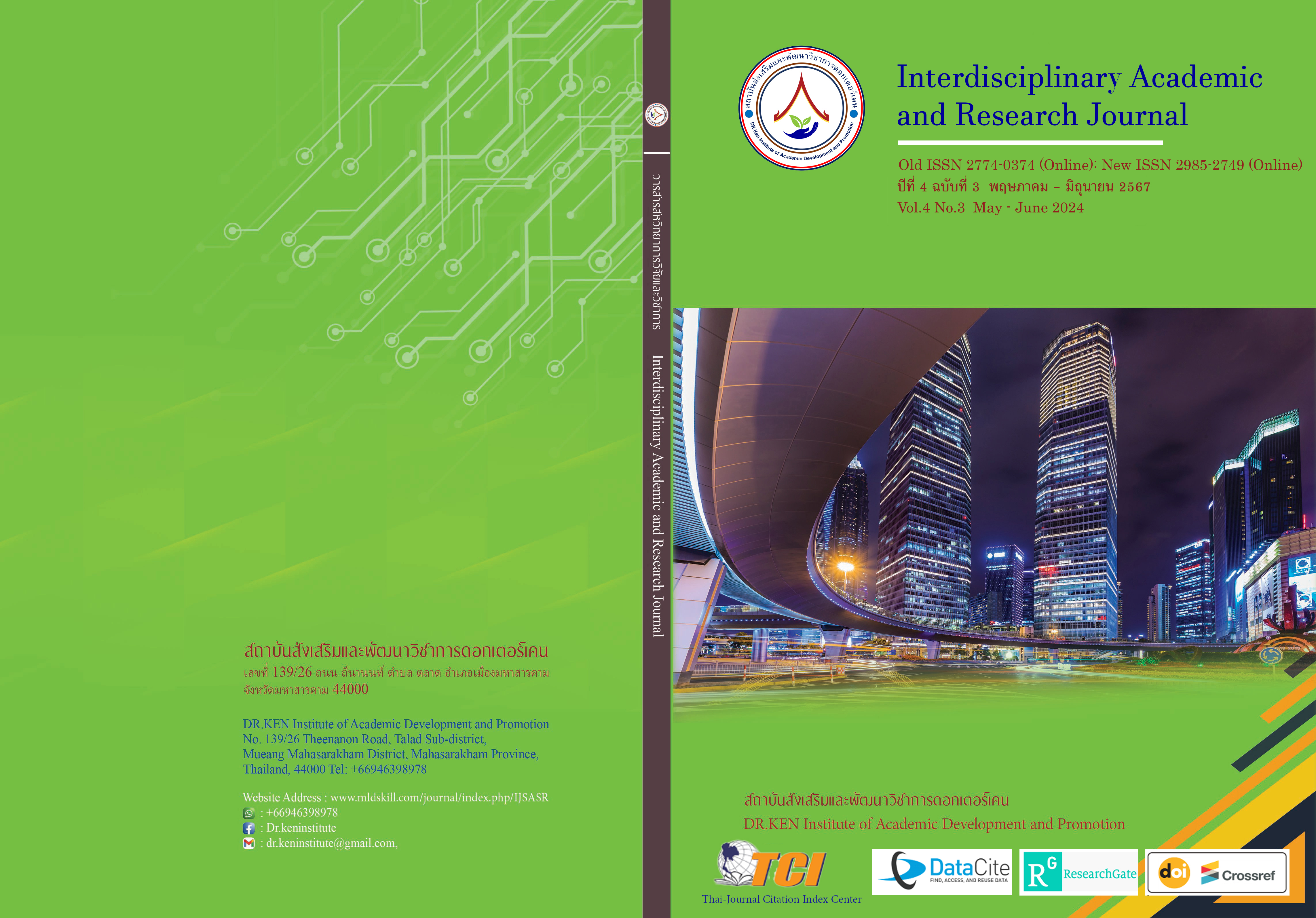Participation Model for Solving Drug Problems in Broken Families: A Case Study of the Roi Kaen Sarasin Provincial Custer
DOI:
https://doi.org/10.60027/iarj.2024.275472Keywords:
Strengthening Community Engagement; , Tackling Drug Addiction; , Broken FamiliesAbstract
Background and Aims: The family is the source of the formation of habits, thoughts, beliefs, values, and attitudes for families with teenagers, family influence has a direct effect on the development of the child's physical and mental personality. If the family is defective, it will inevitably affect family members. There is a lack of balance in the family, affecting inappropriate personality development, and leading to deviant behavior such as drug addiction, which is a national problem at this moment. This research therefore aims (1) to study the drug problem in divided families in Roi Kaen Sarasin Province. (2) To analyze the causes of the drug problem in broken families in Roi Kaen Sarasin province. (3) To study the impact of the drug problem on broken families in Roi Kaen Sarasin Province. And (4) To present a model for participation in solving drug problems in broken families: a case study of the Roi Kaen Sarasin Province group.
Methodology: Qualitative research with 40 interviews and focus group discussions and thematic analysis and content analysis.
Results: (1) The situation of the drug problem in divided families in Roi Kaen Sarasin province was; (1.1) An increasing number of new addicts are evolving from addicts to dealers. (1.2) People who have undergone drug treatment and are unable to quit and return to using it as before. (1.3) Drug traffickers from neighboring countries are increasingly providing drug services to local drug traffickers. (1.4) There are more new, small drug traffickers. And (1.5) There is the same group of drug traffickers or prisoners who have been released from prison and continue with the same behavior. (2) Causes of drug problems in broken families were (2.1) Arises from knowledge of the situation, (2.2) Causes of being deceived, (2.3) Causes of illness. Ans (2.4) Other causes: Living in an area where the epidemic is occurring. (3) The impact of drug problems on broken families were (3.1) Effects at the individual and family level or on the addict, (3.2) Effects at the family level of drug users, (3.3) Impact on society and community, (3.4) National impact. And (4) a model for participation in solving drug problems in broken families were (4.1) Identification of families at risk, (4.2) Creating a support network, (4.3) Creating learning projects. (4.4) Cooperation with experts, (4.5) Defensive strategy planning, (4.6) Access to treatment, (4.7) Empowering families, and (4.8) Long-term support.
Conclusion: The results highlight alarming shifts in drug issues within broken families, including rising addiction-turned-dealing, treatment relapses, and increased involvement of foreign traffickers. Causes range from ignorance to environmental influences. These problems extend beyond families, affecting society and the nation. Effective community intervention is crucial, focusing on risk identification, support networks, education, expert collaboration, and sustained support for families to combat these challenges.
References
กองบัญชาการตรวจปราบปรามยาเสพติด. (2553). สถิติการจับกุมคดียาเสพติด สำนักงานตำรวจแห่งชาติ พ.ศ.2553. กรุงเทพฯ: กองบัญชาการตรวจปราบปรามยาเสพติด.
เดชา ศิริเจริญ. (2555). เด็กกับอิทธิพลของครอบครัว. วารสารนิติศาสตร. 3(8), 12-17.
ธนาภรณ์ เมทณีสดุดี. (2543). ความพึงพอใจของนักท่องเที่ยวต่างประเทศที่มีต่อการรับบริการสื่อวิดีทัศน์ : ศึกษาเฉพาะกรณี วัดพระเชตุพนวิมลมังคลารามราชวรมหาวิหาร. กรุงเทพฯ: มหาวิทยาลัยมหิดล
บุญเลิศ จิตตั้งวัฒนา. (2548). การพัฒนาการท่องเที่ยวแบบยั่งยืน. กรุงเทพฯ: เพรสแอนด์ดีไซน์.
พรศรี พัฒนาพงษ์.(2550). ปัจจัยที่เป็นอุปสรรคต่อการปฏิบัติงานการป้องกันและปราบปรามยาเสพติดใน สถานศึกษา. วิทยานิพนธ์สังคมสงเคราะห์ศาสตรมหาบัณฑิต. บัณฑิตวิทยาลัย: มหาวิทยาลัยธรรมศาสตร์.
พิชิต บับภาเอก. (2552). ปัจจัยที่มีผลต่อการกระทำาผิดของเด็กและเยาวชน: กรณีศึกษาเด็กและเยาวชนในสถานพินิจและคุ้มครองเด็กและเยาวชน. สารนิพนธ์ศิลปศาสตรมหาบัณฑิต มหาวิทยาลัยมหามกุฏราชวิทยาลัย
ยุพา พูนขํา, ประกายดาว พรหมประพัฒน์, กอบกุล ไพศาล อัชพงษ์ และ ธนภูมิ สามัคคีคารมณ์. (2553). การส่งเสริมสุขภาพป้องกันพฤติกรรมเสี่ยงและปัญหาสุขภาพเยาวชน. สำนักอนามัยการเจริญพันธุ์ กรมอนามัย: กระทรวงสาธารณสุข.
วนัญญา แก้วแก้วปาน. (2551) พฤติกรรมอาชญากรรมกับประวัติการใช้ยาเสพติดของเยาวชนในสถานฝึกและอบรมเด็กและเยาวชน [บ้านกรุณา] . กรุงเทพฯ: จุฬาลงกรณ์มหาวิทยาลัย.
วราภรณ์ มั่งคั่ง, จินตนา วัชรสินธุ์ และ วรรณี เดียวอิศเรศ. (2559). ปัจจัยครอบครัวที่มีผลต่อการใช้ยาเสพติดของวัยรุ่นชาย ในศูนย์ฝึกและอบรมเด็กและเยาวชนแห่งหนึ่ง. The Public Health Journal of Burapha University. 11 (2), 53-63.
สันติชัย เอื้อจงประสิทธิ์. (2551). สาระสําคัญของการมีส่วนร่วมของบุคลากร. กรุงเทพฯ : สามเจริญพาณิชย์
สำนักงานกิจการสตรีและสถาบันครอบครัว. (2554). รายงานประจำปี 2554 สำนักงานกิจการสตรีและสถาบันครอบครัว. สำนักงานกิจการสตรีและสถาบันครอบครัว กระทรวงการพัฒนาสังคมและความมั่นคงของมนุษย์.
สำนักงานคณะกรรมการป้องกันและปราบปรามยาเสพติด (สำนักงาน ปปส.). (2561). รายงานผลการดำเนินงานป้องกันและแก้ไขปัญหายาเสพติด ประจำปีงบประมาณ 2561. กรุงเทพฯ : สำนักงานคณะกรรมการป้องกันและปราบปรามยาเสพติด (สำนักงาน ปปส.).
อุทัย กมลศิลป์ และคณะ. (2556). กระบวนการบริหารเชิงยุทธศาสตร์เพื่อป้องกันการแพร่ระบาดยาเสพติด ในศูนย์การศึกษานอกระบบและการศึกษาตามอัธยาศัยอำเภอหนองพอก ปีการศึกษา 2556. ธรรมทรรศน์, 17 (1), 59-71.
Downloads
Published
How to Cite
Issue
Section
License
Copyright (c) 2024 Interdisciplinary Academic and Research Journal

This work is licensed under a Creative Commons Attribution-NonCommercial-NoDerivatives 4.0 International License.
Copyright on any article in the Interdisciplinary Academic and Research Journal is retained by the author(s) under the under the Creative Commons Attribution-NonCommercial-NoDerivatives 4.0 International License. Permission to use text, content, images, etc. of publication. Any user to read, download, copy, distribute, print, search, or link to the full texts of articles, crawl them for indexing, pass them as data to software, or use them for any other lawful purpose. But do not use it for commercial use or with the intent to benefit any business.
















.png)


